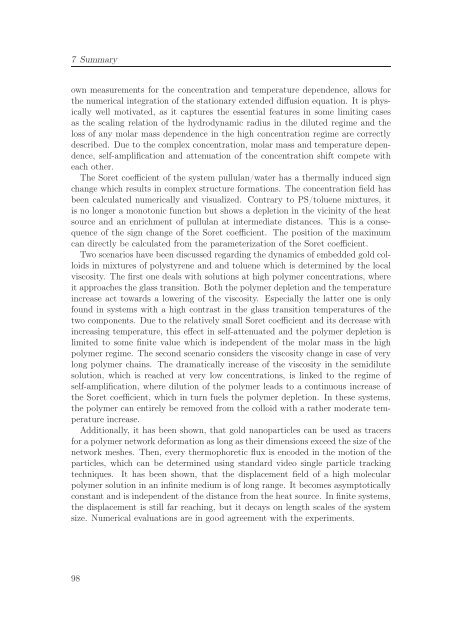diss_SCHWAIGER.pdf - OPUS Bayreuth - Universität Bayreuth
diss_SCHWAIGER.pdf - OPUS Bayreuth - Universität Bayreuth
diss_SCHWAIGER.pdf - OPUS Bayreuth - Universität Bayreuth
Sie wollen auch ein ePaper? Erhöhen Sie die Reichweite Ihrer Titel.
YUMPU macht aus Druck-PDFs automatisch weboptimierte ePaper, die Google liebt.
7 Summary<br />
own measurements for the concentration and temperature dependence, allows for<br />
the numerical integration of the stationary extended diffusion equation. It is physically<br />
well motivated, as it captures the essential features in some limiting cases<br />
as the scaling relation of the hydrodynamic radius in the diluted regime and the<br />
loss of any molar mass dependence in the high concentration regime are correctly<br />
described. Due to the complex concentration, molar mass and temperature dependence,<br />
self-amplification and attenuation of the concentration shift compete with<br />
each other.<br />
The Soret coefficient of the system pullulan/water has a thermally induced sign<br />
change which results in complex structure formations. The concentration field has<br />
been calculated numerically and visualized. Contrary to PS/toluene mixtures, it<br />
is no longer a monotonic function but shows a depletion in the vicinity of the heat<br />
source and an enrichment of pullulan at intermediate distances. This is a consequence<br />
of the sign change of the Soret coefficient. The position of the maximum<br />
can directly be calculated from the parameterization of the Soret coefficient.<br />
Two scenarios have been discussed regarding the dynamics of embedded gold colloids<br />
in mixtures of polystyrene and and toluene which is determined by the local<br />
viscosity. The first one deals with solutions at high polymer concentrations, where<br />
it approaches the glass transition. Both the polymer depletion and the temperature<br />
increase act towards a lowering of the viscosity. Especially the latter one is only<br />
found in systems with a high contrast in the glass transition temperatures of the<br />
two components. Due to the relatively small Soret coefficient and its decrease with<br />
increasing temperature, this effect in self-attenuated and the polymer depletion is<br />
limited to some finite value which is independent of the molar mass in the high<br />
polymer regime. The second scenario considers the viscosity change in case of very<br />
long polymer chains. The dramatically increase of the viscosity in the semidilute<br />
solution, which is reached at very low concentrations, is linked to the regime of<br />
self-amplification, where dilution of the polymer leads to a continuous increase of<br />
the Soret coefficient, which in turn fuels the polymer depletion. In these systems,<br />
the polymer can entirely be removed from the colloid with a rather moderate temperature<br />
increase.<br />
Additionally, it has been shown, that gold nanoparticles can be used as tracers<br />
for a polymer network deformation as long as their dimensions exceed the size of the<br />
network meshes. Then, every thermophoretic flux is encoded in the motion of the<br />
particles, which can be determined using standard video single particle tracking<br />
techniques. It has been shown, that the displacement field of a high molecular<br />
polymer solution in an infinite medium is of long range. It becomes asymptotically<br />
constant and is independent of the distance from the heat source. In finite systems,<br />
the displacement is still far reaching, but it decays on length scales of the system<br />
size. Numerical evaluations are in good agreement with the experiments.<br />
98
















